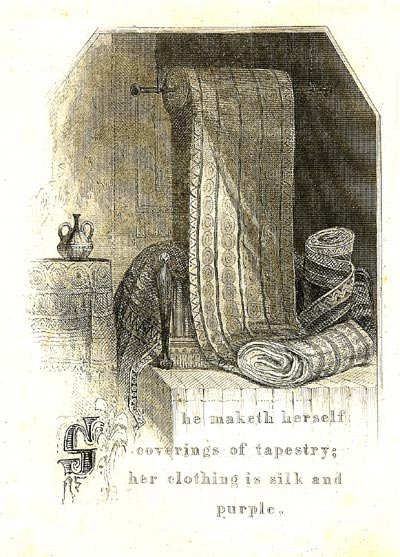*From The Excellent Woman of Proverbs 31 written in 1847 by Anne Pratt (1806-1893)

The celebrated Babylonian tapestries were wrought with the needle, and represented either the mysteries of religion, or some historical incidents; and the Greek and Roman ladies wrought embroideries, which told to the eye a tale of hunting or war, of love or sorrow, and even in those early days wove tapestry, little inferior to that which graces the halls of some of our old English castles and mansions.
Blue, in every variety, was a favourite color with the ancient Hebrews. We find it mentioned continually in the decoration of the Tabernacle, and the dress of the priest; and it is generally thought to have been procured from indigo, which appears from the mummy cloths to have been used by the Egyptians, and was therefore doubtless known to the Jews.
But the purple was the color which appears to have had pre‐eminence in ancient times, and which was so generally appropriated to kings and important personages, that even unto modern days the purple robe is emblematic of royalty.
It was, too, with the purple robe that Mordecai was decked, when he was promoted to honor by the Persian king; and to be clothed in purple and fine linen, was the distinction of the rich man in the parable of the New Testament.
SHE MAKETH HERSELF COVERINGS OF TAPESTRY;
HER CLOTHING IS SILK AND PURPLE.
HER CLOTHING IS SILK AND PURPLE.
Proverbs 31:22

It has ever been, in the East, customary for persons of wealth to dress in magnificent clothing, and to furnish their dwellings in a sumptuous and tasteful manner. There is indeed but little furniture in an oriental house. Couches and sofas, and hangings at the doors, are almost the only objects on which skill can be exercised, or which will admit the display of wealth in the possessor.
The curtains of the Jewish Tabernacle described in the book of Exodus 26-27, "made of fine twined linen, and blue, and purple, and scarlet," are generally supposed to have been made of needlework, in which the Jewish women are known to have excelled.
That pictures describing various scenes of life or landscape were traced by female hands on their tapestries, there can be little doubt. The celebrated Babylonian tapestries were wrought with the needle, and represented either the mysteries of religion, or some historical incidents; and the Greek and Roman ladies wrought embroideries, which told to the eye a tale of hunting or war, of love or sorrow, and even in those early days wove tapestry, little inferior to that which graces the halls of some of our old English castles and mansions.
Blue, in every variety, was a favourite color with the ancient Hebrews. We find it mentioned continually in the decoration of the Tabernacle, and the dress of the priest; and it is generally thought to have been procured from indigo, which appears from the mummy cloths to have been used by the Egyptians, and was therefore doubtless known to the Jews.
But the purple was the color which appears to have had pre‐eminence in ancient times, and which was so generally appropriated to kings and important personages, that even unto modern days the purple robe is emblematic of royalty.
It was, too, with the purple robe that Mordecai was decked, when he was promoted to honor by the Persian king; and to be clothed in purple and fine linen, was the distinction of the rich man in the parable of the New Testament.
The purple mentioned in the text, is believed by most writers to be the highly valued Tyrian dye. This color was known in very ancient times, and prized, not only by the Hebrews, but by the Greeks and Romans. It was procured from two species of fish found on the shores of the Mediterranean and Atlantic seas: the one (buccinum) adhered to the rocks; the other (purpura) floated in the sea, and it was this species which afforded the dye most in request.
In later ages, we read of a very interesting character, Lydia, who was "a seller of purple" at Thyatira, whose "heart the Lord opened, that she attended unto the things which were spoken of Paul," and whose warm and earnest love to the apostle and his companions, urged her to constrain them to dwell in her house (Act 16:14-15); and this rich color, in which the matron of the text is said to be clothed, was probably one of those species of merchandise which she is said, "like the merchants' ships, to have brought from afar."
